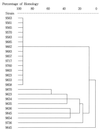Application of infrequent-restriction-site PCR to clinical isolates of Acinetobacter baumannii and Serratia marcescens
- PMID: 10488162
- PMCID: PMC85504
- DOI: 10.1128/JCM.37.10.3108-3112.1999
Application of infrequent-restriction-site PCR to clinical isolates of Acinetobacter baumannii and Serratia marcescens
Abstract
We applied infrequent-restriction-site PCR (IRS-PCR) to the investigation of an outbreak caused by 23 isolates of Acinetobacter baumannii in an intensive care unit from November 1996 to May 1997 and a pseudoepidemic caused by 16 isolates of Serratia marcescens in a delivery room from May to September 1996. In the epidemiologic investigation of the outbreak caused by A. baumannii, environmental sampling and screening of all health care workers revealed the same species from the Y piece of a mechanical ventilator and the hands of two health care personnel. IRS-PCR showed that all outbreak-related strains were genotypically identical and that three strains from surveillance cultures were also identical to the outbreak-related strains. In a pseudoepidemic caused by S. marcescens, IRS-PCR identified two different genotypes, and among them one genotype was predominant (15 of 16 [93.8%] isolates). Extensive surveillance failed to find any source of S. marcescens. Validation of the result of IRS-PCR by comparison with that of field inversion gel electrophoresis (FIGE) showed that they were completely concordant. These results suggest that IRS-PCR is comparable to FIGE for molecular epidemiologic studies. In addition, IRS-PCR was less laborious and less time-consuming than FIGE. To our knowledge, this is the first report of the application of IRS-PCR to A. baumannii and S. marcescens.
Figures



References
-
- Birren B, Lai E. Switch interval and resolution in pulsed field gels. In: Birren B, Lai E, editors. Pulsed field gel electrophoresis: a practical guide. 1st ed. San Diego, Calif: Academic Press, Inc.; 1993. pp. 107–120.
-
- Bollman R, Halle E, Sokolowka-Kohler W, Gravel E L, Buchholz P, Klare I, Tschape H, Witte W. Nosocomial infections due to Serratia marcescens. Clinical findings, antibiotic susceptibility patterns and fine typing. Infection. 1989;17:294–300. - PubMed
-
- Debast S B, Melchers W J, Voss A, Hoogkamp-Korstanje J A, Meis J F. Epidemiological survey of an outbreak of multiresistant Serratia marcescens by PCR-fingerprinting. Infection. 1995;23:267–271. - PubMed
MeSH terms
LinkOut - more resources
Full Text Sources

